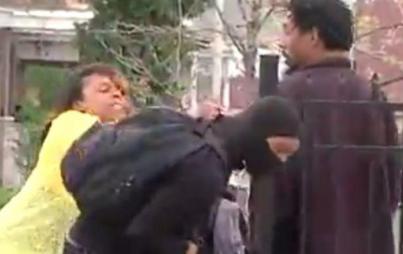
Read more stories from Ravishly's conversation series on police violence against women of color here. Have your own perspective to add? Email ravishly@ravishly.com.
Aiyana Jones will not turn thirteen this year. Her parents will not have the mixed blessing of guiding their daughter through years of teenage tumultuousness, including disagreements about dating, negotiations about curfews, arguments over doing the dishes or cleaning her room, and navigating the ups and downs that accompany adolescent hormones. Instead, they'll continue to grieve for their baby girl—and the lack of accountability for her tragic death.
It was shortly after midnight on May 16, 2010, and the seven-year-old was sleeping peacefully in her grandmother's Detroit apartment. But a swat team mistook their apartment for the one above, hurling a flashbang grenade through the window. Then they rushed in. When he entered, Officer Joseph Weekley shot Aiyana. The bullet went straight through her head, killing her instantly.
Juries failed to reach a verdict in two separate trials. In October 2014, the judge dismissed the involuntary manslaughter charges against Weekley. Then on January 30, 2015, more than seven years after Aiyana's death, the judge also dismissed the lesser charge of reckless use of a firearm.
In other words, no one will be held legally responsible for Aiyana's murder.
Aiyana is just one of a long list of girls and women of color whose lives have been cut short by police violence. But, while the police killings of Michael Brown in Ferguson and Eric Garner in New York have spurred national outcry, incited mass protests and sparked discussions about law enforcement violence, less attention has been paid to the deaths of black women at the hands of police.
In January 2008, Ohio police shot 26-year-old Tarika Wilson while she was holding her one-year-old in her home. (The baby, who was also shot, survived.) In March 2012, 22-year-old Rekia Boyd was hanging out with friends in a Chicago park when she was shot and killed by an off-duty police officer. In February 2014, Yvette Smith, a 47-year-old mother of two, was shot to death by Texas police officers after opening the door of her home to them. In August 2014, 50-year-old Michelle Cusseaux was shot to death by Phoenix police in her own home. In November 2014, 37-year-old Tanesha Anderson died after police slammed her head into the concrete pavement. These are only a handful of examples. While there are many more, we actually don't know how many women of color have been killed by police since no agency keeps complete statistics.
These women's names and stories rarely stick in the public consciousness. Their deaths rarely raise the same level of sustained media attention and protests. These murders should spark outrage and mass mobilizing among both activists organizing against police violence and feminists demanding an end to violence against women. But, with the exception of women of color-led groups like INCITE! Women, Gender Non-Conforming, and Trans people of Color Against Violence and local organizing led by grieving family members, these deaths have fallen through the cracks of other movements. This speaks volumes about how the lives of women of color continue to be devalued.
These tragedies should be creating uproars in many movements and communities. They should trigger conversations that build bridges between racial justice and anti-violence organizing both locally and nationwide. We need to extend our conversations and movements against violence against women to include violence committed by police. At the same time, we need to include women in our discussions and organizing to end police violence. Otherwise, law enforcement violence against women of color will continue to happen—and, tragically, continue to be ignored.







